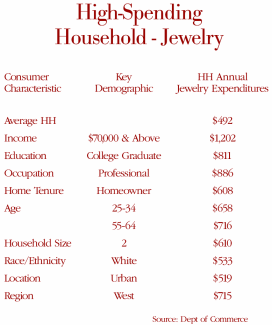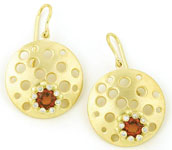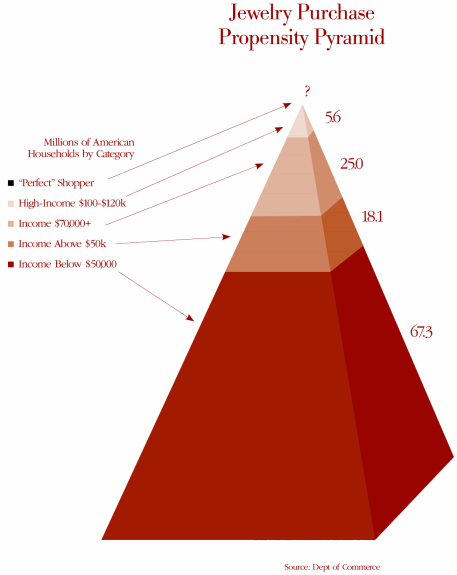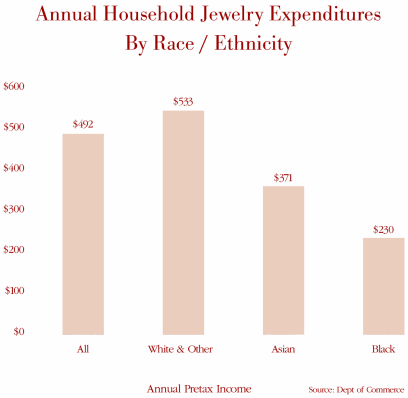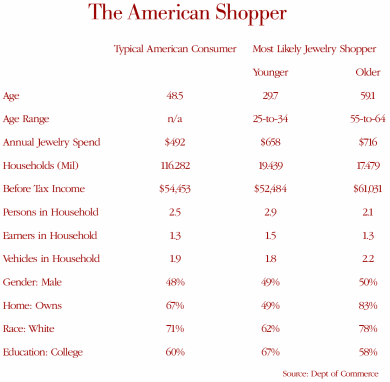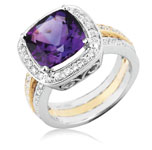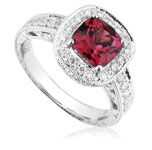A Practical Profiling Guide for Jewelers
October 09, 06 by

The customer was beaming . . . positively radiant. She had just purchased a beautiful diamond solitaire costing thousands of dollars. As the sales person watched her leave the store, he turned to the store owner and said quietly, “I could just smell the money on that shopper.” Unfortunately, most of us do not have the sixth sense – the intuitive ability – to “smell money” on a customer, though some A-list sales people can instinctively recognize the signs of a customer who is about to plunk down serious money for jewelry.
For the rest of us, making “the big sale” comes down to a combination of good sales training and luck.
Demographic Profiling Can Help
Using demographic profiles based on the concepts uncovered by our research, jewelers now have another tool in their sales arsenal to help spot shoppers who are more likely to make a large jewelry purchase and become repeat customers.
Demographic profiling can help jewelers identify customers with a higher propensity to purchase jewelry. Demographic profiling synthesizes the concepts uncovered by our research and allows jewelers to practice them on a daily basis in their stores.
In America, the concept of “profiling” people is politically incorrect; we are supposed to be blind to demographic characteristics. If you don’t believe it, just watch the security personnel at any airport as they frisk your grandmother for weapons while an Al Qaeda look-alike slips through with nary a glance because the computer didn’t randomly pick him for a thorough search.
But the simple fact is this: most of us stereotype people. Perhaps we pick up on physical clues – someone is wearing too much makeup, or someone’s hair needs cutting. The clothes someone wears may remind you of another person, or perhaps mirror your own preferences. When a merchant stereotypes a customer, it unconsciously evokes all prior experiences associated with the pleasure - or consequences – of dealing with that type of person. For example, when jewelers see a young consumer come into their store, they may automatically assume that this shopper will buy an engagement ring rather than an expensive diamond tennis bracelet.
Important: Demographic Profiling Is Not An Excuse for Poor Sales Results
Sales people should never hide behind demographic profiling as an excuse for a small ticket sale or poor sales results. Jewelry sales people should listen to the customer, and provide the best products and services to suit the customer.
Retailing is full of exceptions. For example, while the Department of Commerce research shows that blue collar consumers don’t spend as much on jewelry as white collar consumers, these are simply averages. We’ve seen examples where blue collar workers come into jewelry stores and spend thousands of dollars on jewelry for their spouse.
Demographic profiling is simply one more tool to help sales people qualify a potential customer. It is not a substitute for poor selling skills.
Demographic Profiles Help Target “Ideal” Customers
In a perfect world, a customer would come into a jewelry store with a sign around his or her neck, proclaiming their annual income. That would make it easy for jewelers to judge the potential size of the jewelry sale.
America’s Best Jewelry Customer
If a retail merchant could wave a magic wand, the “perfect” jewelry shopper would earn $118,482 per year. That’s all they would need to know about that shopper. Every time someone earning exactly $118,482 per year walked into a jewelry store, the sales people would know that they were going to make a big sale, and that this customer would likely return often to make additional jewelry purchases.
There are two problems with this theoretical customer:
New Research Identifies “Ideal” Jewelry Shoppers
While there are several ways to quantify a jeweler’s ideal customer – biggest ticket, most repeat visits, highest margin, largest target group, etc. – we have defined the jeweler’s ideal customer as an individual in a household that generates the highest total jewelry expenditures in a one-year period. This takes into account the possibility of both big-ticket sales and repeat visits to the jeweler’s store.
The “ideal” jewelry shopper fits within a fairly wide range of demographic characteristics. The table below summarizes households with the top per-household spending in each major demographic category: age, income, education, etc. As the first line of the table illustrates, the “Average HH (Household)” in America spends about $492 annually on jewelry. Households with high income “$70,000 & Above” (second line) spend nearly two-and-a-half times as much on jewelry - $1,202 - as the typical U.S. household.
From this table, it is clear to see that two demographic age groups have emerged who are spending well above levels that had been forecasted by demographers. These two new groups with a particularly high propensity to spend on jewelry include higher-income consumers age 24-34 and age 55-64. Not only is their per-household spending on jewelry above the national average, but the aggregate spending power of both of these groups is greater than that of Baby Boomer consumers aged 45-54.
Targeting Jewelry Markets Efficiently
In a perfect world, jewelers would be able to identify the perfect customer and would have the perfect piece of jewelry for that customer. There would be enough perfect customers to support all the jewelers in America. Unfortunately, we don’t live in a perfect world.
Merchants achieve operating efficiencies by building product offerings around a group of consumers that is large enough to support a retail niche. For example, luxury jeweler Harry Winston appeals to a very high-end consumer niche; based on the company’s sales and profits, this is a highly desirable market niche. However, if the target market niche is not large enough, merchants may not be able to efficiently reach it; further, the market niche may simply not be
large enough to support retailers trying to target it.
Based on new research from the Department of Commerce, the size of each market segment, beginning with the “perfect” jewelry consumer, is shown on the pyramid on the right. The number of “perfect” jewelry customers is unknown, but it is an extremely small number. It would not make sense for merchants to target a group this small. However, as we increase the size of the income range for consumers with an above-average propensity to purchase jewelry, the number of household targets increases significantly.
As the graph illustrates, there are about 5.6 million households with an annual income in the range of $100,000-to-$120,000. This market is probably too small for most jewelers to target. However, if we increase the income range for households to include all of those with $70,000 and higher annual income, we can see that there are about 30.6 million households in this income category (including the 5.6 million households earning in the range of $100,000-to-$120,000). This market is clearly large enough for most jewelers to
target profitably. If we expand our
target market to households earning above $50,000 annually, a group that typically spends an above average amount on
jewelry, the market size rises to nearly 49 million households.
“Ideal” Jewelry Customer Compared to Typical American “Ideal” jewelry customers differ materially in many respects from the typical American consumer. For example, the ideal jewelry customers are wealthier, better educated, have white collar occupations, and have significantly more discretionary income than the typical American consumer.
The table on the next page compares the typical U.S. consumer with the “ideal” jewelry customer.
The “Real” Ideal Customer
This demographically characterized “ideal” customer may be a jeweler’s best customer, but anyone who walks in the front door of a jeweler’s store is the best potential customer at that moment. As master sales trainer Shane Decker will tell you, anyone who comes into a store wants to do one thing: give you money.
Unfortunately, customers don’t walk into jewelry stores and announce their annual income levels. While income levels are the best predictor of the likelihood of the amount that a shopper will spend on jewelry, it is not easy to determine this information early in the sales process. Therefore, jewelers must look for other clues that will provide guidance to the potential sale.
There are two obvious clues that jewelers can use when customers walk into their stores: race / ethnicity and age.
Race / Ethnicity
We reiterate: it is not politically correct to call attention to one’s race in America. But, our research takes a clinical approach. Race matters – in a big way – when it comes to jewelry purchases. And, it is relatively easy for jewelry sales people to determine the race or ethnicity of most shoppers simply by looking at them.
As the graph bellow illustrates, a white consumer is likely to spend more than twice as much as a black consumer. Asian consumers’ jewelry expenditures are in between the level of white and black consumers.
Age
Most sales people can determine a consumer’s age within a few years, just by looking at them. Since the Department of Commerce consumer expenditure research is summarized using wide age brackets – ten years – it is relatively easy to profile a customer by age when they walk in the front door of a jewelry store.
The good news for jewelry sales associates: if you mis-estimate a consumer’s age, it does not make a substantial difference. Jewelry expenditures vary by age range, but not dramatically, except at either end of the demographic curve.
Other Demographic Factors
Many of the other demographic factors that have an impact on the size of the sale (aside from the skill of the sales person, of course) can be determined in casual conversation or if the customer agrees to fill out a credit application. While not all credit applications require all of the demographic information that is used to segment customers and determine their potential spending, there are some questions that will provide guidance.
-
Income - Higher is better.
-
Occupation - White collar is best; construction workers are also good jewelry customers.
-
Education - More education is better.
-
Homeownership - Homeowners are the best jewelry customers.
Other demographic factors are not nearly as good as predictors of jewelry expenditures. For example, while there is some variation in jewelry expenditures by household size, it is not a meaningful predictor of jewelry expenditures. Region of the
country is not a good predictor, either; the geographic regions are far too broad to be meaningful.
Conclusion
Skilled sales people learn to recognize certain signs that a customer is about to make a major purchase. Perhaps the customer will begin to fidget with his hands; or, his facial muscles will begin to twitch, sending a clear buy signal. Recently, the Financial Times profiled Dolly Lenz, the top-selling real estate broker in the U.S. How does she know when a customer is on the verge of purchasing? Her answer: “You can tell when a man is going to buy. They start to perspire. You can see it in their face. It’s like when men see boobs. It’s that same look.” And now you know what to look for!
JEWELRY SHOPPING FREQUENCY IS DOWN
Over the past two decades, consumers in American households have cut back on shopping trips to their jeweler, according to new consumer research by the U.S. Department of Commerce. In 1984, over 14 percent of all Americans shopped for jewelry in any calendar quarter of the year. By 1994, this had declined to just under 12 percent. In 2004, only about 8 percent consumers in American households bought jewelry in any quarter of the year.
Fewer Die-Hard Jewelry Shoppers Among American households, roughly 3 percent of all shoppers are die-hard jewelry shoppers, according to research by Retail Forward. In 2005, these loyal customers purchased jewelry at least once a month.
However, Retail Forward research also shows that the percentage of loyal customers – those who shop for jewelry monthly – has declined from 4 percent of all U.S. consumers in 2004.
During 2005, Retail Forward research revealed that 14 percent of all American households shopped for jewelry during any six-month time period of the year. This was a decline from 2004 when 19 percent of all U.S. households shopped for jewelry in a six-month period.
Research by the Department of Commerce tends to confirm Retail Forward’s findings. During any quarter in 2004, consumers in about 8 percent of all American households shopped for jewelry. The Commerce Department also says about 4 percent of consumers in American households shopped for watches in any three-month period in 2004.



